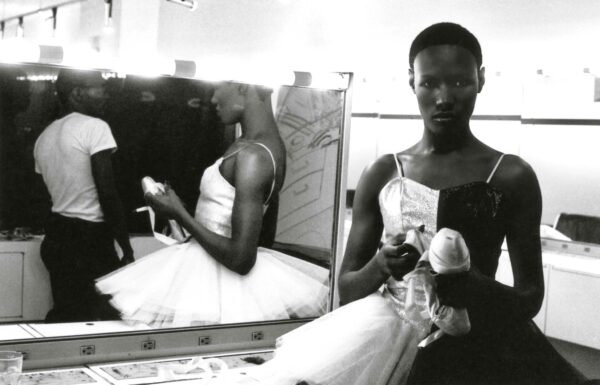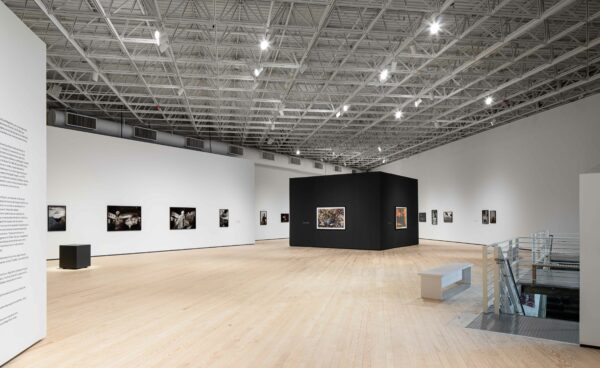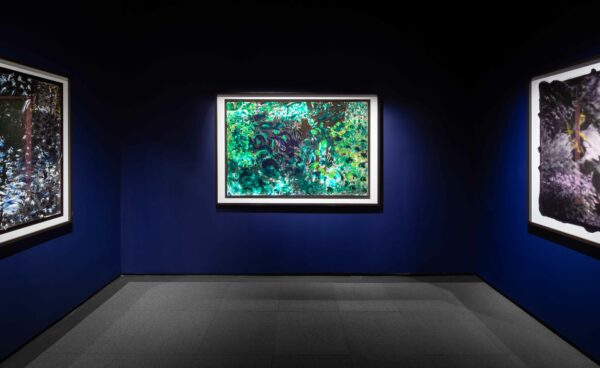Para leer este artículo en español, por favor vaya aquí. To read this article in Spanish, please go here.

Ming Smith, “Amen Corner Sisters (Harlem, New York), 1977, archival pigment print, 24 x 36 inches. Image and work courtesy Ming Smith Studio.
Janice Bond first met Ming Smith ten years ago. In 2020, when Bond became deputy director at the Contemporary Arts Museum Houston, she started talking to Smith and curator James Bartlett about a museum retrospective that has finally come to fruition now, after Bond has left CAMH to open her own space, Art Is Bond. Not content with “conceiving” a retrospective — as noted on the museum’s website — Bond organized a synergetic outpouring of Smith’s work. Thus, there are three Ming Smith shows currently on view in Houston: one in “a cruise ship,” as Bond calls the CAMH (the museum’s acute angles do resemble some kind of naval transport), and two in “boats”: her gallery and Barbara Davis Gallery. Bond wants to create “a critical mass around this historic moment” of different generations and economic brackets, even though the shows exhibit similar, or in some cases, the same work, albeit in different sizes.
By “historic moment,” Bond means Smith’s largest museum show to date. But the moment is years in the making, and the context of the photographer’s rise to the museum level bears some scrutiny. It started through another artist’s sustained attention. In 2017 Arthur Jafa had a show at the zenith of art world visibility, the Serpentine Galleries in London. Jafa decided to share the podium with Norwegian collage artist Frida Orupabo, YouTube creator Missylanyus, and Ming Smith, who he championed as “the greatest Afro-American photographer ever.” Since then, she’s received a lot of attention in the gallery and the U.S. museum world, culminating in a recent lifetime achievement award from the International Center for Photography. Reaching this peak took time, and the institutional biases of race and gender are not entirely to blame, even though they are ever-present. Rather, it’s her curiosity towards all the disparate corners of the visible world a camera can capture that has made her an unlikely subject for museum attention, which oftentimes favors a sense of closure in a given artist’s trajectory.
Smith started taking photos with her mother’s camera when she was five. Supporting herself with a modeling career, she gained recognition early on when Black Photographers Annual, a showcase book published by Ebony magazine, published her portfolio in the very first issue of 1973 and continued to print her photos in all subsequent editions. That same year, Smith had a solo show at Cinandre, a hairdresser salon doubling as a social club a couple of blocks from Central Park in New York. In 1975, she became the first and only female member of a Harlem photographer collective Kamoinge, alongside Anthony Barboza, Louis Draper, Alger Cowans, and others.

Ming Smith, “Grace Jones at Cinandre,” 1974, archival pigment print, 24 x 36 inches. Image and work courtesy Ming Smith Studio.
In an introduction to the Annual’s first edition, Toni Morrison saw the photography book as hovering “over the matrix of black life.” That phrase can describe Ming Smith’s unique position, too: she could be formal, going after urban texture in one moment and social the next, never stopping to box her intuitive orientation through geographies and scenes of Black life in a restrictive bottled message. The CAMH exhibition relays this lack of stilted logic perfectly, mixing iconic images from different eras and series with a recent video work in collaboration with her son, Mingus Murray, and a sound box with music from her ex-husband David Murray, which includes “Ming,” a title composition from his 1980 album that features her on the cover. “Ming is a dreamer,” Bond says, and the show is supposed to be “reflective not only of her work, but of the energetic process.”
Smith’s moment in Houston may be historic, but the lightness of touch betrays no gravity, even when the subjects clearly “have something very heavy on their minds … sometimes so heavy as to be timeless, as in Ming Smith’s ancestral — and yet absolutely present — confrontation,” as James Baldwin noted in his introduction to the 3rd issue of Black Photographers Annual. Both as a model and Murray’s touring companion, Smith traveled through the States, Europe, Japan, and several African countries.
Unsurprisingly, she often gravitated towards music and photographed a lot of avant-garde jazz’s prominent players. These photos are unusual in that Smith allows for a lot of negative space around the figure(s), leaving room for random background ambience. This way a portrait becomes pictorial, not commemorative. Even when a figure is foregrounded, as in the case of Smith’s famous shots of Sun Ra, it dissolves into the air, making the legendary bandleader a cross between a Christmas tree and an alien pilot. Smith also befriended young Grace Jones and took playful pictures of her that could be placed among the very best in the performer’s vast visual biography. Smith’s interest in fiction has also led her to inhabit the world of playwright August Wilson’s characters for a series made in Pittsburgh.

Installation view of “Ming Smith: Feeling the Future” at the Contemporary Arts Museum Houston, 2023. Photo by Sean Fleming.
A seemingly endless variety of subjects and topics makes Smith’s shows feel pleasantly observational. Photographers often have a fixed viewpoint, print size, and skew the horizon just so, but Smith follows no set recipe. This makes her hard to categorize. Photography is often evaluated through its weaponizing by controlling institutions. There exists a venerable tradition of understanding the medium through its use by the power in locations that need surveillance — the colonies, the cities, the market. Individual artistic choices in photography are seen, therefore, as fugitive from the types of profiling that the state or the corporation does. An artist who unveils the surveillance tactics in a gesture of Brechtian estrangement is also much more visible to the cultural systems of talent registration. That is why fellow female photographers Carrie Mae Weems or Lorna Simpson — while younger than Smith — have already had solo shows in multiple museums, including CAMH, in the 1990s, on the strength of their efforts to clarify the mechanics of racial profiling. This type of conceptual criticality finds exhibition opportunities much more often than anything elusive or painterly.
Smith does not do estrangement, so to position her advantageously in the alternative bureaucracies of high art she needed a translation. Jafa’s involvement in Ming Smith’s career makes sense. He’s a quintessentially topical artist, and his politics is very visibly stitched into the images he makes or uses. Jafa volunteered to put her in the right context, and his reading of Smith in a 2020 interview for her Aperture monograph remains among the most incisive. “Black people get tight around photos,” Jafa tells Greg Tate, “because… there’s always a danger that the photograph can be used as evidence against you in some fashion.” In many of Ming’s shots, he posits, “you can’t identify anybody.”
According to an Artforum review by Chloe Wyma, Smith’s work displays a “purported rejection of the medium’s probative burden,” but it also addresses the invisibility of its subjects. This is a topic that is central for much of Black photography, either conceptual or straight. Carrie Mae Weems notes in an interview that “black folks operate under a cloud of invisibility.” “Lorna Simpson,” writes Marta Gili, “analyzes the way in which we imagine the invisible through the visible, while unmasking the prejudices that accompany us when it comes to reconstructing what is not shown.”
Smith’s first art break came in 1979 with the sale of two photographs to MoMA after the museum hosted an open call. When asked by a MoMA curator to choose the shots herself, she decided on a portrait of David Murray, because she did not see a lot of black men on the museum walls. Later, Smith made a series called Invisible Man (1988-1991) in honor of the Ralph Ellison 1952 classic book, and took on societal blind spots, capturing people in motion, folding into darkness, or resembling ink smudges. The titular image of the series has become the centerpiece of a small MoMA monograph published in 2020. It shows a tall hunched figure plodding through the night snow. We presume the figure is Black, but it could be anyone lost in severe weather.

Installation view of “Ming Smith: Feeling the Future” at Contemporary Arts Museum Houston, 2023. Photo by Sean Fleming.
Surveillance and invisibility are concepts, though, and Ming Smith chooses movement over mind. One of the reasons she went to New York was to take dance lessons, as Ohio ballet schools did not allow Black kids. She’s been interested in Katherine Dunham’s modern dance system since the 1970s. Smith frequently compares photography to dance, saying both are states of extreme mental acuity. In an interview with Greg Tate, she said that her dark and textured nude studies were influenced by the dynamics of Auguste Rodin’s The Kiss. Movement makes itself present through the impressionistic ripple effect that she’s often after. Be it iridescent snowflakes or Sun Ra’s gleaming cloak, Harlem night scenes or strokes of paint that she often uses to enhance the image, Smith presses the shutter not to capture the fleeting moment, but to manifest its evanescence.
Ming Smith: Feeling the Future is on view in the Arts Museum Houston through October 1, 2023. Ming Smith: Catching the Light is on view at Art is Bond and Barbara Davis Gallery through September 2, 2023.


